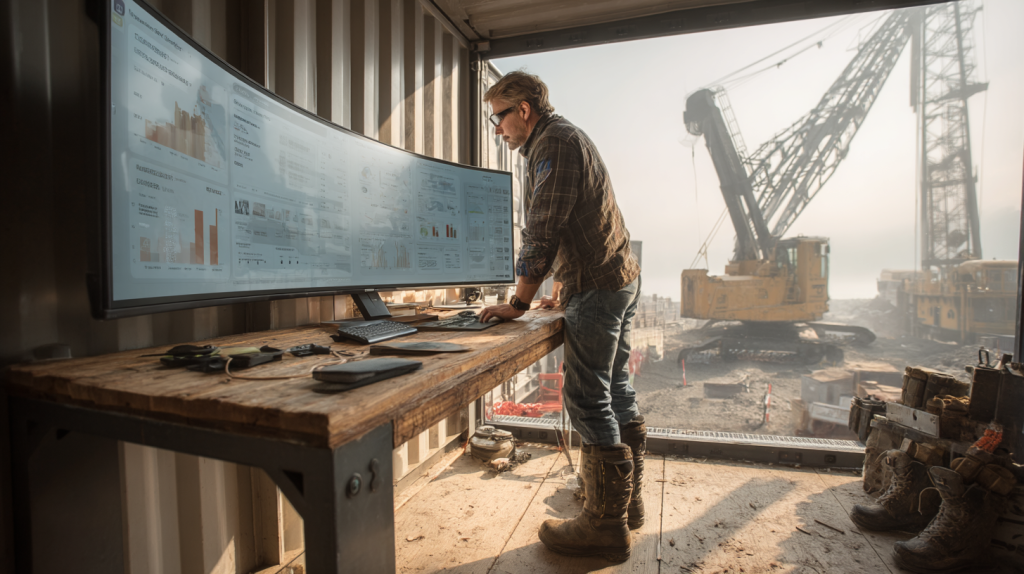Construction Materials Management: How to Track Construction Materials from Warehouse to Jobsite in Real Time
Table of Contents:

In today’s fast-paced construction environment, tracking materials from warehouse to jobsite isn’t just a logistical challenge—it’s a critical factor in keeping your schedule, budget, and field crews on target. Materials delays, misdeliveries, or inventory errors can cause costly setbacks, idle labor, and missed milestones. That’s why real-time tracking has become a game-changer for general contractors, superintendents, and procurement teams who need full visibility and control over their supply chain.
Modern construction materials management software allows you to monitor materials across every stage—when it leaves the warehouse, when it arrives on-site, and when it’s installed. With tools like mobile check-ins, barcode scanning, real-time dashboards, and integration with your scheduling and procurement systems, teams can coordinate more effectively and respond to issues before they escalate.
In this blog, we’ll explore how real-time tracking works, what tools make it possible, and how your field and office teams can use it to eliminate guesswork, reduce waste, and keep your builds running smoothly.
Why Real-Time Materials Tracking Matters in Construction
Materials are constantly in motion—ordered from suppliers, delivered to warehouses, transferred between sites, staged in laydown yards, or installed across multiple trades. Without real-time visibility, teams are forced to rely on outdated spreadsheets, text messages, or memory. This leads to errors, delays, and overordering—none of which your schedule can afford.
Real-time materials tracking gives every stakeholder—from procurement to foremen—instant access to the status and location of key materials. Whether you’re managing large-scale commercial builds or fast-moving residential jobs, the ability to confirm in-transit shipments, verify warehouse stock, and track field usage is a major advantage.
The best systems use mobile apps, QR code scanning, and delivery logs to ensure materials are properly logged at every handoff. With the right process, your team always knows what’s available, what’s coming, and what needs to move next.
Top Benefits
- Full visibility from warehouse to field
Track materials in real time as they move through your supply chain—reducing uncertainty and miscommunication. - Faster issue resolution and fewer delays
Catch missing or incorrect deliveries before they slow down your crews or disrupt the schedule. - Improved productivity across departments
Everyone works from the same data—no more blind spots between procurement, logistics, and field teams.
Best Practices
- Set up tracking checkpoints for every handoff
Confirm location and quantity at warehouse departure, jobsite arrival, and field staging. - Use mobile-enabled scanning tools
Equip field teams with barcode or QR scanners to instantly log material receipts and transfers. - Assign responsibility for updates by role
Make it clear who tracks what—from warehouse leads to foremen—so your system stays accurate.
Real-time tracking isn’t just about logistics—it’s about empowering your team with the clarity they need to build efficiently.
What Tools Are Needed to Track Materials from Warehouse to Jobsite?
To track materials accurately across your supply chain, you need a combination of digital tools that streamline data capture, reduce manual errors, and allow for real-time access. At a minimum, your materials management system should include mobile accessibility, barcode or QR code scanning, inventory tagging, and status alerts.
Start with a cloud-based platform that allows warehouse teams to log what’s leaving and field teams to confirm what’s received. Barcode scanning simplifies this process by reducing data entry and ensuring accuracy. Each scanned item can be linked to a delivery, project, phase, or trade.
GPS tagging and geofencing features also add value, especially when you’re moving high-value items between sites. Your team can track deliveries on the road and verify arrival without waiting for verbal confirmation.
Most importantly, your system should be integrated. Materials data should flow between your procurement system, your scheduling platform, and your daily jobsite tools—so everyone from logistics coordinators to supers can see the full picture.
Top Benefits
- Streamlined material logging and verification
Scan and confirm items quickly, reducing paperwork and preventing inventory errors. - Real-time updates across teams and locations
Field teams, warehouse staff, and office admins all stay on the same page. - Smarter planning and scheduling
Know what materials are available for upcoming phases—before assigning crews or tasks.
Best Practices
- Equip teams with shared mobile tools
Ensure field and warehouse users have easy access to the same platform from their devices. - Label materials clearly at the warehouse
Use tags or barcodes tied to project codes, trade scopes, or installation areas. - Integrate with procurement and schedule tools
Link tracking data to POs and work schedules to improve coordination and forecasting.
The right tools turn your materials movement into a live workflow—fully visible, fully verifiable, and fully under control.

How Can Teams Use This Data to Optimize Daily Jobsite Operations?
Once you have real-time data flowing from warehouse to field, the next step is turning that information into jobsite action. Materials tracking data helps field teams plan their day more effectively, schedule tasks based on confirmed availability, and reduce time lost to guesswork or missing deliveries.
When superintendents can see exactly what arrived this morning—and what’s delayed—they can make informed calls on what work can proceed. Foremen can assign crews to tasks that align with available materials. And if something’s missing, it’s flagged immediately and addressed by procurement or logistics, rather than becoming a bottleneck.
Jobsite control also improves when deliveries are staged intentionally. Instead of dumping materials in bulk, field teams can prepare storage zones based on real-time schedules, keeping things organized and reducing damage or theft.
Most importantly, your daily reports become more accurate. Materials status can be logged alongside productivity, inspections, and task progress—giving PMs and execs a full picture of how materials impact site performance.
Top Benefits
- Increased labor efficiency
Crews stay productive when they know materials are ready and jobs are sequenced appropriately. - Reduced jobsite clutter and confusion
With real-time tracking, you only bring what’s needed—avoiding excess deliveries or misplacement. - Improved project reporting and forecasting
Daily updates reflect what’s actually happening—not just what was planned.
Best Practices
- Review materials status during daily huddles
Make it a habit to review what’s been received and what’s expected each morning. - Use real-time data to adjust short-term schedules
If materials are late, pivot work without scrambling—and document the impact. - Log delivery photos and notes immediately
Build accountability by capturing conditions and assigning follow-up tasks in real time.
When field teams act on real-time data, they move faster, make fewer mistakes, and keep your project on track.
How Does Real-Time Materials Visibility Reduce Risk and Waste?
Inaccurate or delayed material data often results in reordering, overstocking, rushed logistics, or field crews left waiting—none of which your schedule or budget can afford. Real-time visibility reduces these risks by making materials movement transparent and actionable.
With access to up-to-date status at every step—warehouse departure, in-transit updates, jobsite receipt—your teams can catch issues before they spiral. For example, if a delivery is short or damaged, the system can trigger an alert, document the issue, and flag it for resolution immediately. This avoids misinstallations, delays, and finger-pointing between field teams and procurement.
Waste is also reduced through smarter planning. When materials are visible in real time, you’re less likely to order extra “just in case.” You can also identify surplus materials at one site and transfer them to another before expiration, damage, or theft occurs.
Over time, historical data from real-time tracking also helps your team forecast better. By comparing order quantities with actual usage, you refine takeoffs, reduce excess, and improve vendor negotiations.
Top Benefits
- Prevents overordering and emergency reorders
Teams only request what’s actually needed—based on live usage and availability data. - Reduces on-site waste and spoilage
Better delivery timing and storage reduce damage, loss, and material aging. - Improves accountability across teams and vendors
Every item is documented and time-stamped—minimizing disputes and oversights.
Best Practices
- Review materials flow data monthly for trends
Identify recurring delays, overages, or losses so you can optimize your process. - Standardize issue reporting in the field
Use mobile photo uploads and comments to flag problems the moment they occur. - Track usage by work area or trade
Understand where materials are consumed and align future orders accordingly.
When your teams can see material movement in real time, they waste less, respond faster, and plan smarter.
Related Articles:
What Is the Best Software for Construction Materials Management and Tracking
Top Construction Materials Tracking Software for Inventory, Deliveries, and Jobsite Control
Best Construction Materials Management Software for Tracking Inventory and Orders

StruxHub
Experience the power of StruxHub today and witness firsthand how it can revolutionize your construction operations.
What Role Does Technology Play in Enhancing Delivery Accuracy?
Accurate deliveries are the foundation of jobsite productivity. But when there’s a breakdown between what’s ordered, what’s shipped, and what’s received, problems pile up. Technology bridges this gap by creating a transparent, verifiable chain of custody for every shipment.
Using barcode or QR code scanning, warehouse teams can log items as they leave. GPS or delivery logs update status in transit. When materials arrive, field teams can scan, photograph, and verify delivery—logging quantity, condition, and delivery time instantly. That data is accessible to procurement, PMs, and logistics in real time.
This creates accountability on both sides of the transaction. Vendors are held to performance metrics. Field teams confirm deliveries quickly and accurately. And if something goes wrong, there’s a full record of what was expected vs. what arrived.
Technology also supports more efficient scheduling. When your team sees what’s actually available (not just what was supposed to show up), they can reassign tasks, coordinate staging, and prevent domino-effect delays across trades.
Ultimately, technology gives you the confidence that materials will be where they’re needed, when they’re needed—and if not, you’ll know immediately.
Top Benefits
- Fewer discrepancies between orders and deliveries
Each handoff is logged and verified—so nothing “falls off the truck” unnoticed. - Stronger vendor accountability and performance tracking
Delivery delays, damage rates, and reliability can be tracked and used to inform future purchasing. - Better coordination with jobsite schedules
Deliveries are planned and verified against field needs—supporting smoother task sequencing.
Best Practices
- Use barcode scanning at every handoff point
Don’t rely on verbal confirmation—document everything digitally. - Integrate with your PO and scheduling tools
Ensure that delivery tracking is aligned with your plan and procurement workflow. - Create delivery performance scorecards for vendors
Use historical data to reward reliable suppliers—and hold underperformers accountable.
Tech-enabled delivery accuracy is the difference between reactive firefighting and proactive field execution.
How Does Real-Time Tracking Support Better Jobsite Planning?
Jobsite planning depends on knowing when materials are available—and when they’re not. Without clear tracking, supers and foremen are left guessing, leading to stalled crews, missed sequencing, and site clutter. Real-time materials tracking gives your team the clarity they need to plan workdays with confidence.
For example, if flooring adhesives aren’t arriving until Thursday, your super can adjust the installation schedule and reassign crews. If drywall is ready early, they can fast-track that task and push inspections ahead of schedule.
This level of agility leads to smoother trade coordination, better equipment usage, and fewer overtime hours spent catching up. It also reduces congestion on site. By planning material deliveries based on actual status, you avoid having too many trades—and too many pallets—competing for space.
Even safety improves. Properly timed and staged materials reduce clutter in walkways, allow safer use of machinery, and prevent makeshift storage in dangerous zones.
The key is turning tracking data into daily jobsite action—and the best materials software makes that process seamless.
Top Benefits
- Improved trade coordination and sequencing
Plan tasks based on what’s truly ready—not what was expected on paper. - Reduced site congestion and logistics headaches
Deliver just enough, just in time—keeping space clear and crews mobile. - Higher productivity and fewer schedule delays
When plans are built on real data, you lose less time to last-minute adjustments.
Best Practices
- Include delivery status in your daily coordination meetings
Adjust short-term plans proactively rather than reacting on the fly. - Use tags and notes to align materials with phases
Label deliveries based on upcoming tasks to avoid premature storage or movement. - Monitor upcoming delivery gaps in advance
Flag shortages or high-risk shipments early to maintain momentum.
Real-time materials data turns jobsite planning from guesswork into precision—keeping every task and trade moving forward.
Related Articles:
Best Construction Procurement Management Software for General Contractors and Superintendents
Best Procurement Management Software for Construction: Faster Bids and Better Materials Management
How StruxHub Supports Real-Time Materials Execution in the Field
StruxHub helps bridge the gap between your materials data and the people who need to act on it—your field teams. While many materials management systems focus on procurement and logistics, StruxHub ensures that material readiness is tied to task planning, communication, and daily execution.
Once a material delivery is logged—whether it’s staged in the yard, stored in a container, or in-transit—StruxHub helps your superintendents and foremen assign tasks based on that status. Need to prep for installation? A task is created. Waiting on missing components? The delay is flagged and tracked. Staging needs inspection before install? It’s added to the team’s daily agenda.
StruxHub also allows teams to upload photos, add notes, and tag issues in real time. Instead of waiting for an email or paperwork to move, your team acts faster—and the whole project stays in sync.
Unlike standalone tracking systems, StruxHub integrates material updates into the broader jobsite rhythm—connecting deliveries to labor, tasks, and project milestones.
Top Benefits
- Connects material readiness directly to jobsite tasks
Turn deliveries into action—whether it’s installation, inspection, or issue resolution. - Improves jobsite awareness and reduces response times
Everyone from PMs to field crews can see and act on material updates immediately. - Supports field-first communication
Notes, photos, and task tags make material status clear without back-and-forth emails.
Best Practices
- Use StruxHub to log delivery-related tasks and blockers
Assign staging, inspection, and installation based on material status. - Include materials reviews in your daily check-ins
Update your crews on what’s coming, what’s arrived, and what’s still pending. - Tag issues in real time with location, trade, or schedule phase
Make materials coordination part of the task—not an extra step.
StruxHub makes real-time tracking useful—not just visible—so your team stays productive, aligned, and ahead of the curve.
Related Articles:
Best Guide to Construction Management Software
The Best Guide to Delivery Management Systems (DMS) for Commercial Construction

FAQ
What are the key challenges in tracking materials from warehouse to jobsite?
Tracking materials across the construction supply chain involves multiple handoffs, changing jobsite conditions, and fast-moving logistics—all of which make it easy for materials to go missing, arrive late, or become misallocated. The biggest challenge is lack of visibility across teams. Often, warehouse staff, procurement managers, superintendents, and foremen are working from different systems—or worse, from memory or manual logs.
This creates breakdowns in communication and slows response times. If the field doesn’t know when materials are shipping or whether a delivery is complete, crews can be left idle or forced to shift plans last minute. Similarly, if the warehouse isn’t updated on changes in the build schedule, they may dispatch materials too early, risking theft, clutter, or damage on site.
Another major challenge is documentation. Many teams rely on paper delivery slips, untracked emails, or photo texts with no standardized workflow. This leads to disputes about whether something arrived on time or in good condition—and makes closeout or compliance audits much harder to manage.
Lastly, transferring materials between job sites or returning excess inventory adds more complexity. Without a clear system to track these movements, materials get “lost in transit” or remain unused—wasting money and creating logistical bottlenecks.
The solution lies in implementing a real-time, mobile-friendly platform that standardizes how materials are tracked at every stage: ordered, shipped, delivered, staged, and used. When every team has access to the same live data, you eliminate silos, improve coordination, and reduce the friction that slows your build down.
How does real-time tracking support just-in-time (JIT) material delivery?
Just-in-time (JIT) material delivery is a lean construction strategy that ensures materials arrive exactly when they’re needed—no earlier, no later. It minimizes site congestion, reduces material damage, and cuts costs tied to overordering or storage. But JIT only works when you have complete visibility into material status. That’s where real-time tracking software becomes essential.
Without real-time updates, coordinating JIT deliveries is risky. A missed delivery window or delayed notification could stall crews, create safety hazards, or disrupt tightly sequenced tasks. However, with real-time tracking, the moment materials leave the warehouse or are logged for delivery, all relevant teams are notified. The field knows what’s coming, procurement sees what’s in motion, and everyone can coordinate accordingly.
For example, if HVAC equipment is scheduled to arrive Tuesday morning, the site lead can assign staging space and installation crews in advance. If a supplier delay occurs, the platform flags it and the team pivots—reassigning labor or rescheduling related trades to avoid downtime.
Real-time tracking also makes it easier to enforce supplier accountability. You can monitor vendor reliability, compare promised vs. actual delivery times, and use the data to make smarter procurement decisions going forward.
JIT requires precision and timing. Real-time tracking provides the infrastructure to support that timing—ensuring deliveries are not only efficient, but synchronized with the daily rhythm of your build. It’s the foundation of a more responsive, organized, and cost-effective jobsite.
What features should I look for in real-time materials tracking software?
When selecting materials tracking software, look for features that support live coordination, accurate documentation, and mobile-first workflows. Your platform should serve both office and field users with real-time updates that eliminate blind spots between procurement, warehousing, and jobsite crews.
At the core, you want live delivery tracking. This includes shipment statuses, in-transit alerts, and confirmation upon jobsite arrival. The software should support barcode or QR code scanning for quick check-ins and allow field teams to upload delivery photos and notes. GPS tagging and geofencing can further enhance accuracy for high-value materials or remote sites.
Inventory management is another essential. You need to track current stock levels, consumption trends, and upcoming reorders—all organized by project, trade, or location. Systems that link inventory with procurement and scheduling are especially valuable, helping you plan installations based on actual material readiness.
Task integration is also important. The best tools connect material deliveries to actionable jobsite tasks—such as staging, inspection, or installation. That means your team isn’t just logging deliveries; they’re using that data to move the job forward.
Documentation tools round out the feature set. Your platform should allow you to attach spec sheets, submittals, and compliance records to each material or batch. This is critical for inspections, warranty claims, and closeout packages.
Lastly, prioritize platforms with mobile apps that work offline. Many job sites have limited connectivity, and crews still need to scan, log, or review material data on the spot.
Choosing a platform with these features ensures you’re not just tracking materials—you’re transforming the way your teams coordinate and execute every day.
How does this software improve coordination between field and warehouse teams?
Field and warehouse coordination is often a weak link in the materials workflow. The warehouse may have accurate inventory, but if that data doesn’t reach the field in time—or vice versa—materials get delivered to the wrong place, at the wrong time, or in the wrong quantity. Real-time materials tracking software solves this by creating a live bridge between warehouse operations and jobsite execution.
With shared access to a centralized platform, warehouse teams can see what’s been requested, prepare loads accordingly, and update delivery statuses the moment trucks leave. Jobsite teams, in turn, can track shipments in real time, see what’s en route, and plan staging or installations around that data.
When a delivery arrives, the field can scan it, verify contents, log condition, and note any discrepancies—all of which the warehouse team sees instantly. If something’s wrong, both sides are looped in immediately, reducing finger-pointing and accelerating resolution.
The software also helps standardize communication. Instead of relying on texts, calls, or printed load lists, teams work from digital logs with photo documentation, task assignments, and auto-notifications. Everyone knows what’s been requested, what’s shipping, and what’s still pending.
Over time, the system builds a history of materials movement—helping you analyze performance, optimize delivery schedules, and ensure your supply chain runs smoothly. The result is stronger alignment, faster response times, and better outcomes for both field and warehouse teams.
How does StruxHub enhance real-time materials tracking for construction teams?
StruxHub complements your materials tracking system by making materials data usable and visible where it matters most: in the field. It turns information about deliveries, inventory, and material readiness into actionable tasks that align with your project schedule, daily priorities, and on-site realities.
When a material delivery is confirmed in your inventory system, StruxHub lets you assign a task for that delivery—whether it’s staging, verification, or installation prep. Your foreman can open the app, see the task, log a photo, and confirm completion—keeping field and office in sync without back-and-forth emails.
StruxHub also helps track and resolve issues faster. If something is damaged or missing, the team can tag it inside a task, assign responsibility, and comment in real time. These issues don’t sit in someone’s inbox—they’re logged, tracked, and resolved with full visibility.
You can also link materials status to progress tracking. Want to know whether drywall installation is delayed because materials haven’t arrived? StruxHub shows you the full chain: task blocked, delivery delayed, crew reassigned. This level of insight helps project managers adjust early and keep schedules moving.
Where inventory systems stop, StruxHub picks up—turning material status into coordination, accountability, and execution.




